Exploring the past and present diets of Hungary provides valuable insights into the rich culinary heritage and evolution of food practices in the region. One study conducted by an international research group focused on the diets of the Great Hungarian Plain populations from the Middle Neolithic to the Late Bronze Age. Researchers used stable isotope and dental microwear analyses to study the diets of these ancient people. The results showed that during the Middle Neolithic period, people consumed meat and cereals like wheat, einkorn, and barley. The diets varied between different sites, showcasing the diverse nature of traditional foods in Hungary. The study also revealed significant changes in agriculture and settlement patterns during the transition from the Neolithic to the Copper Age, with an increased focus on animal husbandry and a greater reliance on cattle. This exploration of the past and present diets of Hungary sheds light on the cultural and historical development of the region.
Key Takeaways:
- The diets of ancient Hungarian populations varied based on geographical sites during the Middle Neolithic to Late Bronze Age.
- Traditional Hungarian cuisine is characterized by the use of meats, seasonal vegetables, fresh bread, dairy products, cheeses, and fruits.
- Signature dishes in Hungarian cuisine include goulash soup, fisherman’s soup, stuffed cabbage, and lángos (fried bread).
- Hungary is renowned for its desserts, such as Dobos cake and Túró Rudi, as well as its wines, including Tokaj and Eger.
- Exploring the past and present diets of Hungary provides insights into the cultural and historical development of the region.
Ancient Diets of Hungary: Middle Neolithic to Late Bronze Age
The diets of ancient Hungarian populations from the Middle Neolithic to the Late Bronze Age reveal fascinating insights into the food practices of the time. A study conducted by an international research group focused on the diets of the Great Hungarian Plain populations during this period. By using stable isotope and dental microwear analyses, the researchers were able to shed light on the types of food consumed by these ancient people.
The study found that during the Middle Neolithic period, the inhabitants of Hungary relied on a combination of meat and cereals for sustenance. Cereals such as wheat, einkorn, and barley were a significant part of their diet, providing them with a source of carbohydrates. Meat from various animals also played a crucial role in their diet, providing essential proteins and fats.
Interestingly, the researchers discovered variations in diets between different sites. This suggests that food preferences and availability varied across different regions of ancient Hungary. Moreover, the transition from the Neolithic to the Copper Age brought about significant changes in agriculture and settlement patterns, with a notable increase in the importance of animal husbandry and reliance on cattle as a valuable food resource.
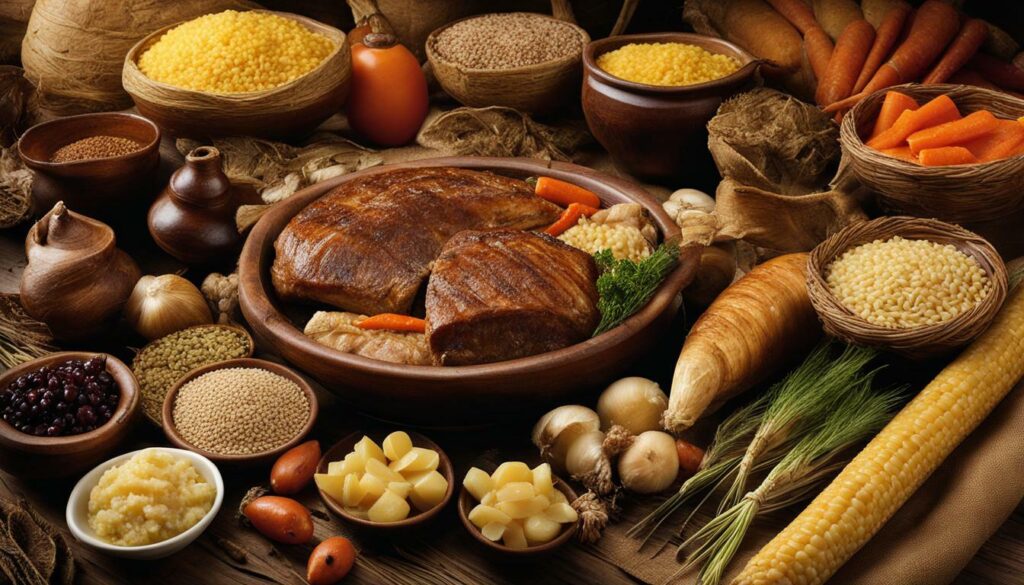
Table: Examples of Ancient Hungarian Food Practices
| Period | Food |
|---|---|
| Middle Neolithic | Cereals (wheat, einkorn, barley), meat |
| Late Bronze Age | Increase in reliance on cattle for food |
The combination of stable isotope and dental microwear analyses allowed researchers to gain a comprehensive understanding of the diets of ancient Hungarian populations. These findings not only provide valuable insights into the past but also contribute to our knowledge of the cultural and historical development of the region’s food practices.
Traditional Hungarian Cuisine
Traditional Hungarian cuisine is renowned for its delightful combination of meats, seasonal vegetables, and a rich variety of flavours. This gastronomic heritage is a reflection of Hungary’s history, geography, and cultural influences. Hungarian dishes are known for their hearty and comforting nature, making them a favourite among both locals and visitors.
The cuisine is centred around traditional ingredients such as pork, beef, lamb, poultry, and freshwater fish. These meats are often combined with an array of seasonal vegetables, including cabbage, peppers, tomatoes, and root vegetables. Herbs and spices such as paprika, dill, parsley, and garlic are used generously to add depth and complexity to the flavours. The use of dairy products such as sour cream and cheeses like túró and bryndza further enhance the richness of Hungarian dishes.
Popular traditional Hungarian meals include goulash soup, a hearty beef stew seasoned with paprika and other spices, and fisherman’s soup, a spicy fish soup made with fresh river fish and paprika. Stuffed cabbage, known as töltött káposzta, is another beloved dish, consisting of cabbage leaves filled with a mixture of ground meat, rice, and spices. Lángos, a deep-fried bread topped with sour cream and grated cheese, is a popular street food enjoyed by many.
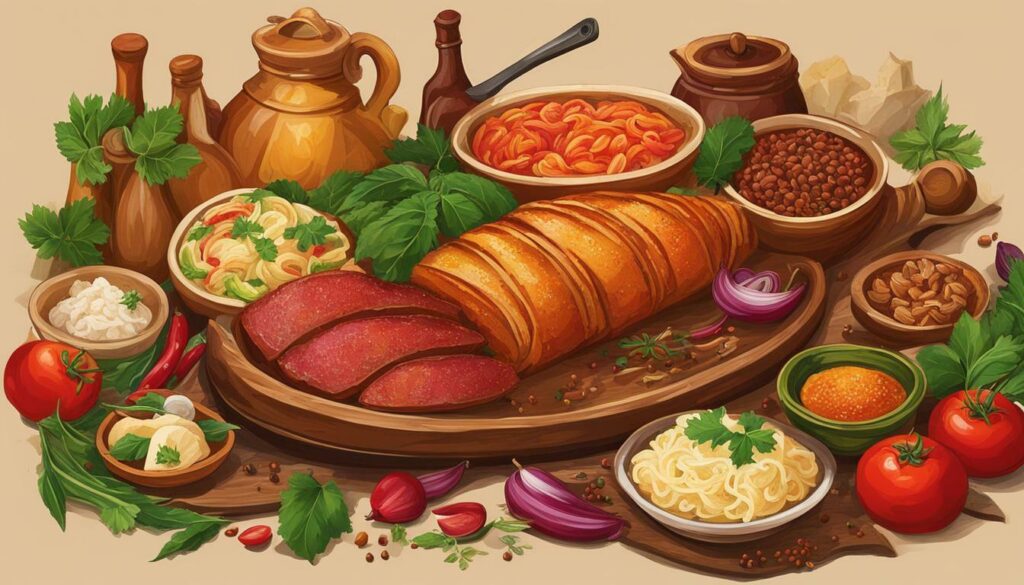
Popular Hungarian Desserts and Wines
No meal in Hungary is complete without indulging in their famous desserts. Dobos cake, a layered sponge cake with chocolate buttercream and caramel topping, is a beloved classic. Túró Rudi, a chocolate-covered cottage cheese treat, is a popular choice for those with a sweet tooth.
Hungary is also renowned for its exceptional wines. Tokaj, a sweet wine made from grapes affected by noble rot, is considered one of the world’s finest dessert wines. Eger, on the other hand, is known for its full-bodied red wines, particularly Egri Bikavér (Bull’s Blood), a blend of local grape varieties.
| Dish | Description |
|---|---|
| Goulash soup | A hearty beef stew seasoned with paprika and spices. |
| Fisherman’s soup | A spicy fish soup made with freshwater fish and paprika. |
| Stuffed cabbage | Cabbage leaves filled with a mixture of ground meat, rice, and spices. |
| Lángos | Deep-fried bread topped with sour cream and grated cheese. |
“Traditional Hungarian cuisine is a celebration of bold flavours and hearty ingredients. From the comforting goulash soup to the indulgent Dobos cake, every bite tells a story of Hungary’s culinary heritage.”
Hungarian Cuisine: A Culinary Blend of Influences
Hungarian cuisine is a captivating blend of influences, reflecting the country’s rich history and multicultural heritage. Throughout the years, Hungary has been shaped by various neighbouring countries and historical events, which have left their mark on its traditional dishes and culinary practices. This fusion of flavours and techniques creates a unique and unforgettable dining experience for locals and visitors alike.
One of the key influences on Hungarian cuisine comes from the Ottoman Empire, which occupied Hungary for several centuries. During this time, the Ottomans introduced spices such as paprika, cinnamon, and saffron, which are now essential ingredients in many Hungarian dishes. The Ottoman influence is particularly evident in dishes like Pörkölt, a traditional Hungarian stew flavoured with paprika, and Túrós Csusza, a pasta dish topped with cottage cheese.
Another significant contributor to Hungarian cuisine is the Austrian-Hungarian Empire, which brought with it a love for hearty, rich flavours. This influence can be seen in dishes like Wiener Schnitzel, a breaded and fried veal or pork cutlet, and Dobos cake, a layered sponge cake topped with caramel.
Hungarian cuisine is a captivating blend of influences, reflecting the country’s rich history and multicultural heritage.
Hungarian cuisine also draws inspiration from its own agricultural traditions, with an emphasis on fresh and seasonal ingredients. The fertile plains of Hungary provide an abundance of fruits, vegetables, and grains, which are used in dishes such as Lecsó, a flavorful pepper and tomato stew, and Hortobágyi palacsinta, savory pancakes filled with meat and topped with a rich sauce.
| Traditional Hungarian Dishes | Ingredients |
|---|---|
| Goulash soup | Beef, potatoes, carrots, onions, paprika |
| Fisherman’s soup | Freshwater fish, paprika, onions, garlic |
| Stuffed cabbage | Cabbage leaves, ground meat, rice, sauerkraut |
| Lángos | Dough, fried and topped with various toppings |
With its rich culinary history and diverse influences, Hungarian cuisine continues to evolve and adapt to modern tastes. Contemporary chefs and food enthusiasts are exploring new flavour combinations and experimenting with innovative cooking techniques, while still honouring traditional recipes and ingredients. This dynamic blend of old and new ensures that Hungarian cuisine remains a vibrant and exciting part of the country’s cultural heritage.
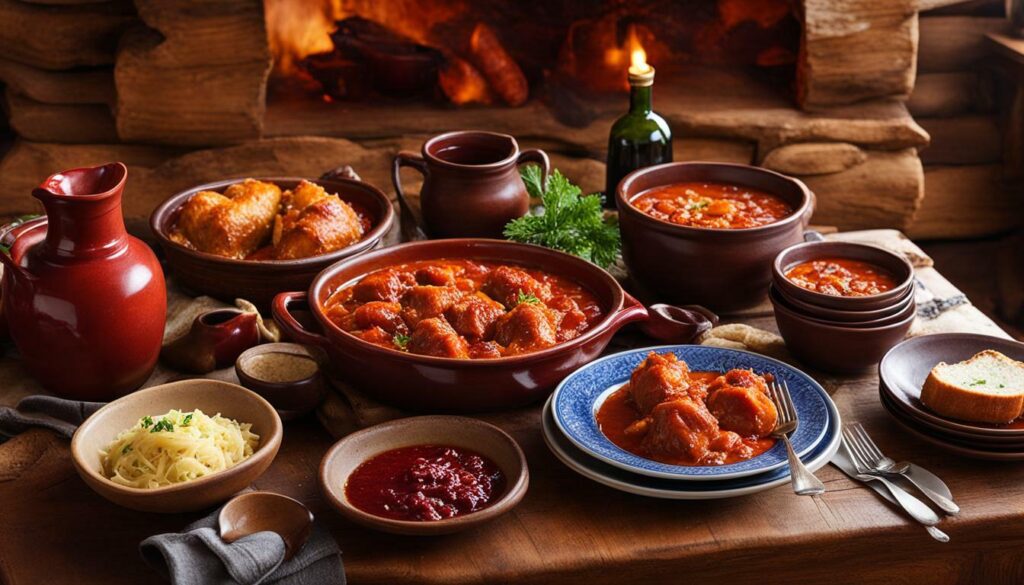
In summary, Hungarian cuisine is a delightful reflection of the country’s history and multicultural influences. From the Ottoman Empire to the Austrian-Hungarian Empire, each era has left its indelible mark on the dishes that make up Hungarian cuisine. With its hearty stews, flavorful spices, and emphasis on fresh ingredients, Hungarian cuisine offers a truly unique and tantalizing dining experience.
Festive Foods in Hungary
Festive foods play a central role in Hungarian celebrations, preserving traditions and showcasing the country’s culinary excellence. Throughout the year, various festivals and special occasions are marked with a delectable array of traditional dishes that have been passed down through generations.
One iconic dish that holds the title of the Hungarian national dish is goulash, a hearty and flavoursome soup made with tender beef, paprika, onions, and a medley of vegetables. It is traditionally cooked in a cauldron over an open fire, infusing the soup with rich smoky flavours. Goulash is often enjoyed during festivities, bringing people together to share in its warmth and comforting taste.
Another celebrated dish during Hungarian festivals is the fisherman’s soup (Halászlé), which originates from the Great Hungarian Plain. This deliciously spicy soup is made with a combination of freshwater fish, paprika, and onions. It is served hot and garnished with fresh parsley, adding a vibrant touch to the dish. Fisherman’s soup symbolizes the country’s deep connection to its rivers and lakes, as well as the pride and skill of Hungarian fishermen.
To complement the main dishes, traditional Hungarian desserts are a must. One such dessert is Dobos cake, named after its creator, József Dobos. This layered cake consists of thin sponge cake layers filled with rich chocolate buttercream and topped with a crunchy caramel layer. The presentation of this cake is a work of art, with a distinctive fan-shaped caramel decoration on top. Dobos cake epitomizes the indulgence and elegance of Hungarian desserts.
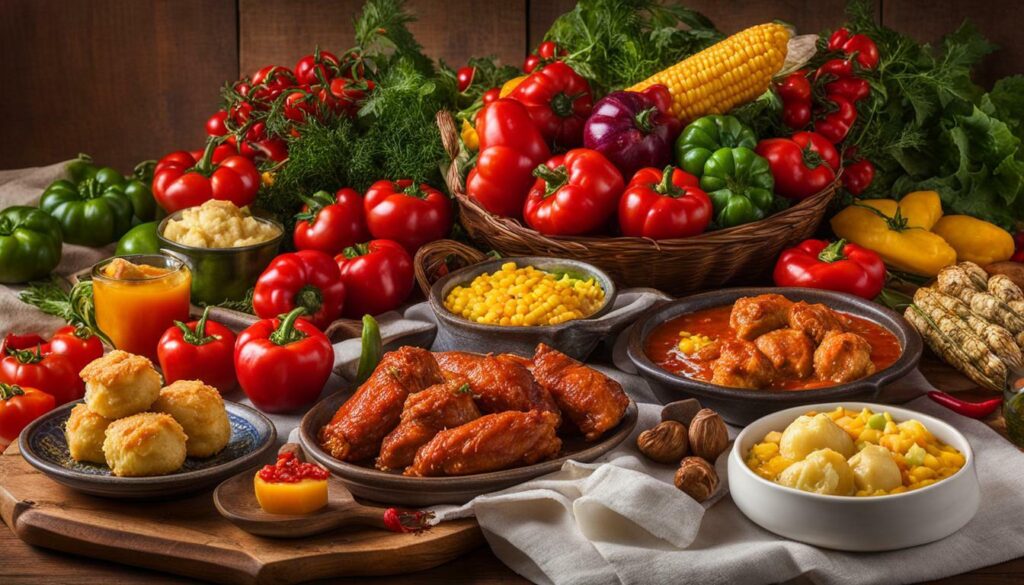
Table: Traditional Hungarian Festive Foods
| Traditional Dish | Significance |
|---|---|
| Goulash | Hungarian national dish, symbolizes unity and warmth |
| Fisherman’s Soup | Represents Hungary’s connection to its rivers and lakes |
| Dobos Cake | Exemplifies the elegance and indulgence of Hungarian desserts |
These festive dishes, alongside many others, are a testament to Hungary’s culinary heritage and the importance of preserving cultural traditions through food. Whether it’s a grand celebration or a small gathering, these culinary delights bring people together and create lasting memories. Festive foods in Hungary not only satisfy the taste buds but also serve as a gateway to experiencing the rich cultural tapestry of the country.
Hungarian Street Food. Video Tour
Contemporary Food Trends in Hungary: Embracing Modernity
Hungary’s culinary landscape has seen a vibrant transformation, with contemporary food trends adding a modern twist to traditional flavours. As the nation embraces the opportunities brought by globalization, Hungarian cuisine has evolved to cater to changing tastes and preferences. While traditional Hungarian dishes continue to hold a special place in the hearts of locals and tourists alike, a new wave of innovative culinary creations has emerged, drawing inspiration from both local and international influences.
One popular trend in Hungarian cuisine is the fusion of traditional ingredients with modern cooking techniques. Chefs have begun experimenting with unique flavour combinations, presenting dishes that are visually appealing and full of unexpected surprises. This creative approach has allowed for the incorporation of international ingredients and cooking styles, resulting in a diverse and exciting culinary landscape.

| Contemporary Food Trends in Hungary | Description |
|---|---|
| Farm-to-Table Movement | Hungarian chefs are increasingly sourcing their ingredients from local farms and markets, ensuring the freshness and quality of their dishes. This focus on using locally sourced produce not only supports local farmers but also promotes sustainability. |
| Street Food Revolution | Street food has gained popularity in Hungary, with food trucks and markets offering an array of delicious and convenient options. From gourmet burgers to artisanal ice creams, the street food scene embraces a wide range of culinary delights. |
| Vegetarian and Vegan Options | As the demand for plant-based meals continues to rise, Hungarian restaurants have started offering vegetarian and vegan options on their menus. These dishes highlight the vibrant flavors of fruits, vegetables, and legumes, showcasing the versatility of plant-based ingredients. |
With the emergence of these contemporary food trends, Hungary’s culinary scene has become a destination for food enthusiasts seeking both traditional and innovative dining experiences. From cosy local eateries to upscale fine dining establishments, there is something to satisfy every palate. Whether indulging in a classic Hungarian dish or exploring the latest culinary creations, visitors to Hungary are sure to be captivated by the country’s rich gastronomic heritage.
The Influence of History and Culture on Hungarian Diets
Hungarian diets are deeply influenced by the country’s rich history and cultural practices, resulting in a captivating blend of flavours and food traditions. Throughout the centuries, Hungary has been shaped by various influences, including its neighbouring countries and historical events. These influences have left a lasting impact on the types of food consumed in the region, making Hungarian cuisine unique and diverse.
One of the key factors that have shaped Hungarian diets is the country’s geographical location. Situated at the crossroads of Europe, Hungary has been exposed to a variety of culinary traditions from neighbouring countries such as Austria, Slovakia, Serbia, and Romania. This has led to the incorporation of different ingredients and cooking techniques into Hungarian dishes, creating a fusion of flavours.
Furthermore, Hungary’s history of invasions and occupations has also played a significant role in shaping its food culture. Over the centuries, Hungary has been under the rule of various empires, including the Ottoman Empire and the Austro-Hungarian Empire. Each of these influences has left its mark on Hungarian cuisine, introducing new ingredients and culinary practices.
Traditional Hungarian dishes reflect this rich history and cultural heritage. They often include hearty meats like beef, pork, and game, combined with fragrant spices and fresh herbs. Traditional dishes such as goulash, a hearty meat and vegetable stew, and stuffed cabbage rolls showcase the country’s love for bold flavours and comforting meals.
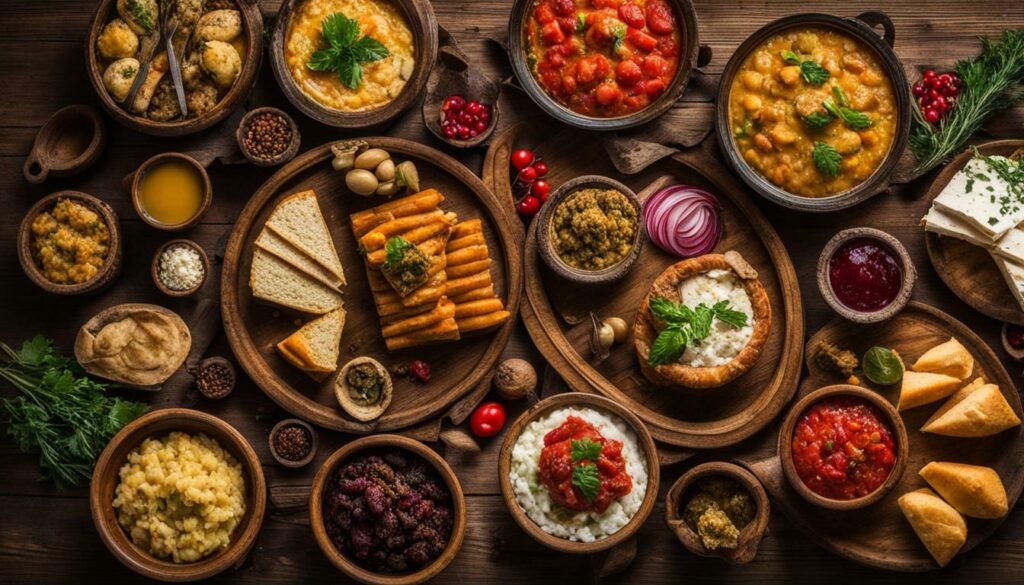
| Traditional Hungarian Dishes | Description |
|---|---|
| Goulash | A flavorful meat and vegetable stew, often seasoned with paprika. |
| Fisherman’s Soup | A spicy soup made with freshwater fish, paprika, and a variety of vegetables. |
| Stuffed Cabbage | Cabbage leaves stuffed with a savoury filling of ground meat, rice, and spices. |
| Lángos | A popular street food, deep-fried dough topped with garlic, cheese, or sour cream. |
In addition to savoury dishes, Hungary is also known for its mouthwatering desserts. Pastries like Dobos cake layered with chocolate buttercream and caramel, and Túró Rudi, a sweet curd cheese covered in chocolate, are cherished treats in Hungarian households.
The rich history and cultural diversity of Hungary continue to shape its food culture, making it a culinary destination worth exploring. Whether you’re indulging in traditional Hungarian dishes or trying the innovative creations of modern Hungarian chefs, you’re sure to be captivated by the unique flavours and fascinating food traditions that Hungary has to offer.
The Indulgence of Hungarian Cuisine: A Culinary Journey
Embark on a delightful culinary journey through the indulgence of Hungarian cuisine, savouring the unique flavours and aromas of traditional recipes and food dishes. Hungarian cuisine is a harmonious fusion of influences from neighbouring countries and historical events, resulting in a rich and diverse culinary heritage.
The cornerstone of Hungarian cuisine lies in the use of high-quality ingredients, such as meats, seasonal vegetables, fresh bread, dairy products, cheeses, and fruits. Traditional Hungarian meals are known for their hearty and flavoursome nature, satisfying both the stomach and the soul. One iconic dish is the famous goulash soup, a rich and savoury beef stew flavoured with paprika and a variety of aromatic spices. Another must-try dish is the fisherman’s soup, a spicy and tangy soup traditionally made with freshwater fish and served with crusty bread.
No exploration of Hungarian cuisine would be complete without tasting the delectable stuffed cabbage, a dish that showcases the culinary artistry of Hungary. Tender cabbage leaves are carefully rolled and filled with a savoury mixture of ground meat, rice, and seasonings, then slow-cooked to perfection. And for those seeking a truly indulgent treat, lángos is a must-try. This golden-fried bread topped with various savoury or sweet toppings is a popular street food that will leave your taste buds craving more.
To complement these mouthwatering dishes, Hungary is also renowned for its delectable desserts. The iconic Hungarian Dobos cake, with its layers of sponge cake and chocolate buttercream, is a true delight for any sweet tooth. Túró Rudi, a creamy cottage cheese bar covered in rich chocolate, is another beloved treat that has become synonymous with Hungarian confectionery.
As you savour these culinary delights, don’t forget to pair them with some of Hungary’s famous wines. Tokaj, known for its sweet and aromatic flavours, is a prized dessert wine that has been enjoyed for centuries. Eger, on the other hand, offers a range of full-bodied reds and crisp whites that perfectly complement the rich flavours of Hungarian cuisine.

Traditional Hungarian Dishes
| Traditional Hungarian Dishes | Description |
|---|---|
| Goulash soup | A rich and savoury beef stew flavoured with paprika and aromatic spices. |
| Fisherman’s soup | A spicy and tangy soup traditionally made with freshwater fish. |
| Stuffed cabbage | Cabbage leaves rolled and filled with a savoury mixture of ground meat, rice, and seasonings, slow-cooked to perfection. |
| Lángos | Golden-fried bread topped with various savoury or sweet toppings. |
| Dobos cake | A layered sponge cake with chocolate buttercream. |
| Túró Rudi | A creamy cottage cheese bar covered in rich chocolate. |
Conclusion
Exploring the past and present diets of Hungary offers a fascinating insight into the cultural and historical development of the region’s cuisine, showcasing the richness and diversity of Hungarian culinary heritage. One study conducted by an international research group focused on the diets of the Great Hungarian Plain populations from the Middle Neolithic to the Late Bronze Age. Through stable isotope and dental microwear analyses, the researchers uncovered valuable information about the diets of ancient people.
During the Middle Neolithic period, people in Hungary consumed a variety of foods including meat and cereals like wheat, einkorn, and barley. However, the exact composition of these diets varied between different sites, highlighting the regional differences in food practices. Additionally, the study revealed significant changes in agriculture and settlement patterns during the transition from the Neolithic to the Copper Age, with a greater emphasis on animal husbandry and an increased reliance on cattle.
In addition to the study of ancient diets, Hungary’s contemporary cuisine is also renowned for its diverse and delicious offerings. Traditional Hungarian dishes are based on a combination of meats, seasonal vegetables, fresh bread, dairy products, cheeses, and fruits. Goulash soup, fisherman’s soup, stuffed cabbage, and lángos (fried bread) are some of the popular meals enjoyed by locals and visitors alike. Hungarian desserts, such as Dobos cake and Túró Rudi, are known for their indulgent flavours, while wines like Tokaj and Eger have gained international acclaim.
Overall, delving into the past and present diets of Hungary not only reveals the evolution of human subsistence practices, but also highlights the cultural significance of food in the region. From ancient times to the modern era, Hungarian cuisine has been shaped by historical events, cultural influences, and local traditions, creating a diverse culinary tapestry that continues to captivate food enthusiasts around the world.
FAQ
What is the importance of exploring the past and present diets of Hungary?
Exploring the past and present diets of Hungary is important in understanding the evolution of human subsistence practices in the region and the cultural and historical development of the area.
What research has been conducted on the diets of ancient Hungarian populations?
One study conducted by an international research group focused on the diets of the Great Hungarian Plain populations from the Middle Neolithic to the Late Bronze Age. Stable isotope and dental microwear analyses were used to study the diets of these ancient people.
What did the study reveal about the diets during the Middle Neolithic period?
The study showed that during the Middle Neolithic period, people in Hungary consumed meat and cereals like wheat, einkorn, and barley. The diets varied between different sites.
How did agriculture and settlement patterns change during the transition from the Neolithic to the Copper Age?
The study also found significant changes in agriculture and settlement patterns during the transition from the Neolithic to the Copper Age in Hungary. There was an increased focus on animal husbandry and a greater reliance on cattle.
What are some traditional Hungarian dishes?
Traditional Hungarian dishes include goulash soup, fisherman’s soup, stuffed cabbage, and lángos (fried bread). Hungary is also known for its desserts like Dobos cake and Túró Rudi, and its famous wines such as Tokaj and Eger.
What influences have shaped Hungarian cuisine?
Hungarian cuisine has been influenced by neighboring countries and historical events, resulting in a unique blend of flavors and culinary techniques that make it stand out.
What are some festive foods in Hungary?
Festive foods in Hungary are an integral part of celebrations and include traditional dishes prepared during special occasions and festivals. The national dish of Hungary also plays a significant role in representing the country’s culinary heritage.
How has Hungarian cuisine embraced modernity?
Hungarian cuisine has evolved to embrace modernity while retaining traditional flavors. There are popular contemporary dishes and food innovations that have gained popularity among locals and tourists.
How has history and culture influenced Hungarian diets?
History and culture have played a significant role in shaping Hungarian diets. Certain foods hold cultural and traditional significance in Hungarian culture, reflecting the country’s rich culinary heritage.
What makes Hungarian cuisine indulgent and appealing?
Hungarian cuisine is indulgent and appealing due to its wide range of flavors, ingredients, and cooking techniques. Traditional recipes and popular food dishes contribute to the enjoyment of Hungarian cuisine by locals and visitors alike.
What is the conclusion of exploring the past and present diets of Hungary?
The exploration of the past and present diets of Hungary provides insights into the cultural and historical development of the region. Hungarian cuisine continues to evolve, contributing to the culinary world.
Source Links
- http://studyinhungary.hu/living-in-hungary/menu/hungarian-cuisine.html
- https://phys.org/news/2021-04-diets-ancient-peoples-great-hungarian.html
- https://journals.plos.org/plosone/article?id=10.1371/journal.pone.0197214



